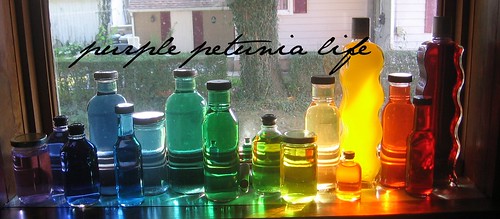My kool-aid selection:
 For each mini dyeing batch, I filled a glass bowl or casserole half full of water, then added a "good glug" (as advised by my fiber muse, Miss Dotty we know from the pharmacy who runs the knitting club at the library and is a force behind the cohesion and continuance of the local fiber guild) of white vinegar. See, lovely fake fruitiness rather ruined from the beginning...sigh...
For each mini dyeing batch, I filled a glass bowl or casserole half full of water, then added a "good glug" (as advised by my fiber muse, Miss Dotty we know from the pharmacy who runs the knitting club at the library and is a force behind the cohesion and continuance of the local fiber guild) of white vinegar. See, lovely fake fruitiness rather ruined from the beginning...sigh...We used two packets of drink mix per batch. Dotty uses 4 in a big pickle jar, placed in the sun for heat. I used the microwave, lacking pickle jars and hours of sunlight. The girls chose to mix pink lemonade and cherry and pink lemonade and grape for their batches. The green is 2 green apples and the orange/yellow 2 mangos.
 I chose to dye the uncarded, washed wool. Lots of my wool had tons of vegetable matter still in it after washing (primary washing interest is to remove the lanolin; since you can't agitate the wool or it will felt, the "dirt" comes out, but the plentiful bits of plants don't, though tons settles out wherever the wool sits for long. I shook my dry wool to get out lots of it), and I chose relatively clean chunks for this dyeing.
I chose to dye the uncarded, washed wool. Lots of my wool had tons of vegetable matter still in it after washing (primary washing interest is to remove the lanolin; since you can't agitate the wool or it will felt, the "dirt" comes out, but the plentiful bits of plants don't, though tons settles out wherever the wool sits for long. I shook my dry wool to get out lots of it), and I chose relatively clean chunks for this dyeing.I first soaked the wool in tap water and more vinegar. I did this because Dotty told me to, but I think that getting it good and wet makes the dyeing more even. She recommended soaking an hour, which probably would have been more even. I just dunked it because I am exceedingly patient and because I like a bit of uneven dyeing. It's interesting. This wool is in the blue bucket.
The girls loaded the wet wool into their casseroles with the prepared kool-aid mix.

We gently pressed the wool into the dye to help it saturate, being careful not to agitate and felt it.
 I covered and microwaved the casseroles in rotation, sort of a heat-then-soak-then-heat-again sort of thing. I zapped them for two minutes each, then moved them to the back of the line. Each got 3 or 4 microwave turns. The heat helps the dye transfer to the wool; it can be provided with sunlight or on the stove, too. You know your wool is "done" when the liquid portion is colorless.
I covered and microwaved the casseroles in rotation, sort of a heat-then-soak-then-heat-again sort of thing. I zapped them for two minutes each, then moved them to the back of the line. Each got 3 or 4 microwave turns. The heat helps the dye transfer to the wool; it can be provided with sunlight or on the stove, too. You know your wool is "done" when the liquid portion is colorless.
 I rinsed the wool in my kitchen sink dishdrainer, then worried I was agitating it too much with my spray and finished the rinsing by moving to my washer, doing the same washing and spinning dry method I used to wash the wool originally, minus the high (140') heat and detergent (Dawn original blue!): Fill the washer with water, add mesh bags of wool and allow to sink into the water. Allow to soak, stringently avoid agitation, and spin dry.
I rinsed the wool in my kitchen sink dishdrainer, then worried I was agitating it too much with my spray and finished the rinsing by moving to my washer, doing the same washing and spinning dry method I used to wash the wool originally, minus the high (140') heat and detergent (Dawn original blue!): Fill the washer with water, add mesh bags of wool and allow to sink into the water. Allow to soak, stringently avoid agitation, and spin dry.I spread it on a towel to finish drying, and:
Fruity wool!
 Next: carding.
Next: carding. look at the pretty, fluffy wool! You've come a long way, baby...
look at the pretty, fluffy wool! You've come a long way, baby...Audrey is using dog brushes to card our washed wool: they're a nicer size for sweet little hands. Plus rather more economical and available!




2 comments:
is these candies?
sorry i didnt get everything i'm french
(just clicked next blog on my blogspot page)
no, I was dyeing wool!
Post a Comment